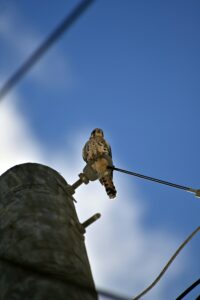Now is a good time to look for hawks and falcons on your interstates and divided highways …..
 Earlier this week, Cleon and I drove about 25 miles to one of the cities closest to us to do some shopping – and to have a big breakfast that I did not have to cook. Always a real treat for me! As we drove home on the 15 miles of a divided 4-lane highway, we saw 7 Red-tailed Hawks perched in the big trees that are all along that stretch of highway.
Earlier this week, Cleon and I drove about 25 miles to one of the cities closest to us to do some shopping – and to have a big breakfast that I did not have to cook. Always a real treat for me! As we drove home on the 15 miles of a divided 4-lane highway, we saw 7 Red-tailed Hawks perched in the big trees that are all along that stretch of highway.

This time of year – and all through winter – are good times to look for hawks and falcons perched along highways – either in trees, on overhead utility wires and poles, or on fence posts. Highway departments mow every fall along these highways all over the country so the grass or plants are short. This makes it much easier for these raptors – with their outstanding eyesight – to spot rodents.
Out here in central Illinois, the two raptors that I most often see are the Red-tailed Hawk and the American Kestrel – a small falcon. The Red-tailed Hawk will most often be perched – motionless – in a big tree, on a fence post, or on top of a utility pole. This makes it hard to see that red tail, but what you can often see is the white on its breast. The white is in somewhat of a circular pattern from its chin to the center of its breast. Below this white patch will be a band of light brown streaking – not always easy to see. But that white patch against the dark brown of the feathers on its head, folded wings and back does stand out. I don’t know of any other common hawk that has that physical trait.
 The American Kestrel is a beautiful small bird – about the size of a robin, but stockier. In flight, its body shape and how it moves can look like a Mourning Dove. Both male and female kestrel have brown backs and white breasts with darker streaks or splotches. The male has beautiful slate blue wings while the female’s are the same brown as her back. Unfortunately, those colors are hard to see when driving on the highway at 65mph. What you will notice is behavior. You might see a kestrel flapping its wings hard and fast, the tail will be fanned, and the bird will be hovering fairly high above the ground. It will be looking down. When doing this, the kestrel is looking for prey and is ready to pounce. I don’t know of any other bird you will see along the interstate – and especially over the large mown areas between the lanes – with this behavior. Kestrels will also perch on utility wires and their silhouettes can resemble both robins and doves, but the bird is stocky. Muscular. Like a robin or dove on steroids. The silhouette can also resemble a really big parakeet. Also, notice where the bird is looking. Most birds when sitting on utility wires are looking out or around. Kestrels are most often looking down – again looking for prey.
The American Kestrel is a beautiful small bird – about the size of a robin, but stockier. In flight, its body shape and how it moves can look like a Mourning Dove. Both male and female kestrel have brown backs and white breasts with darker streaks or splotches. The male has beautiful slate blue wings while the female’s are the same brown as her back. Unfortunately, those colors are hard to see when driving on the highway at 65mph. What you will notice is behavior. You might see a kestrel flapping its wings hard and fast, the tail will be fanned, and the bird will be hovering fairly high above the ground. It will be looking down. When doing this, the kestrel is looking for prey and is ready to pounce. I don’t know of any other bird you will see along the interstate – and especially over the large mown areas between the lanes – with this behavior. Kestrels will also perch on utility wires and their silhouettes can resemble both robins and doves, but the bird is stocky. Muscular. Like a robin or dove on steroids. The silhouette can also resemble a really big parakeet. Also, notice where the bird is looking. Most birds when sitting on utility wires are looking out or around. Kestrels are most often looking down – again looking for prey.

Picking out physical traits – even one as large as the white breast of the Red-tailed Hawk or seeing if a bird is looking down when sitting on a wire – is hard to do when you are in a speeding car, and you should never do it if you are the driver. But if you are the passenger, try. It takes practice, but your eyes will become quicker as time goes on. Highways in fall and winter are wonderful places to look for raptors!


